#tarotqabalahtraditionalmagickelitarot2strikingly.com
Above all things, know thyself!

Radiant: Rider-Waite-Smith-Tarot, Ace of Swords
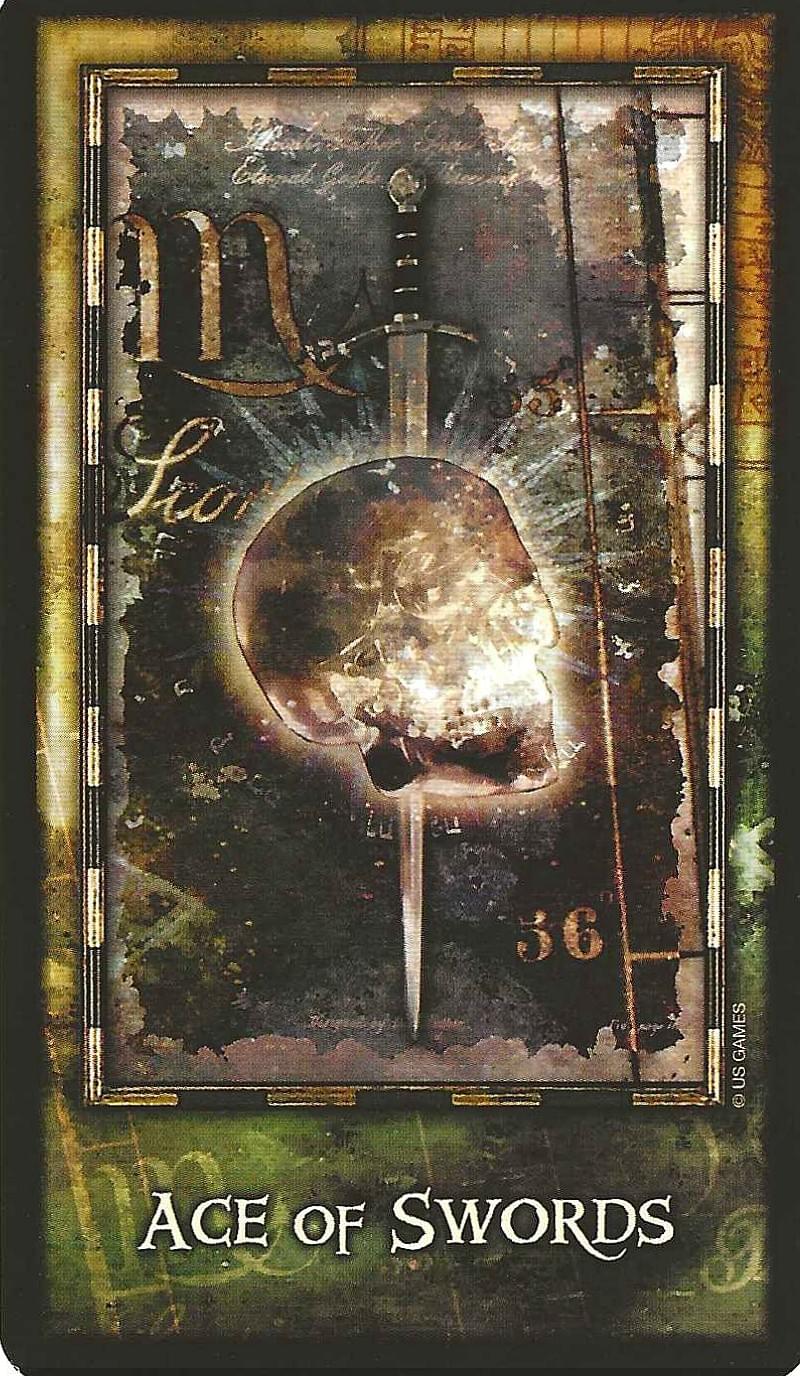
The Archeon Tarot-Ace of Swords
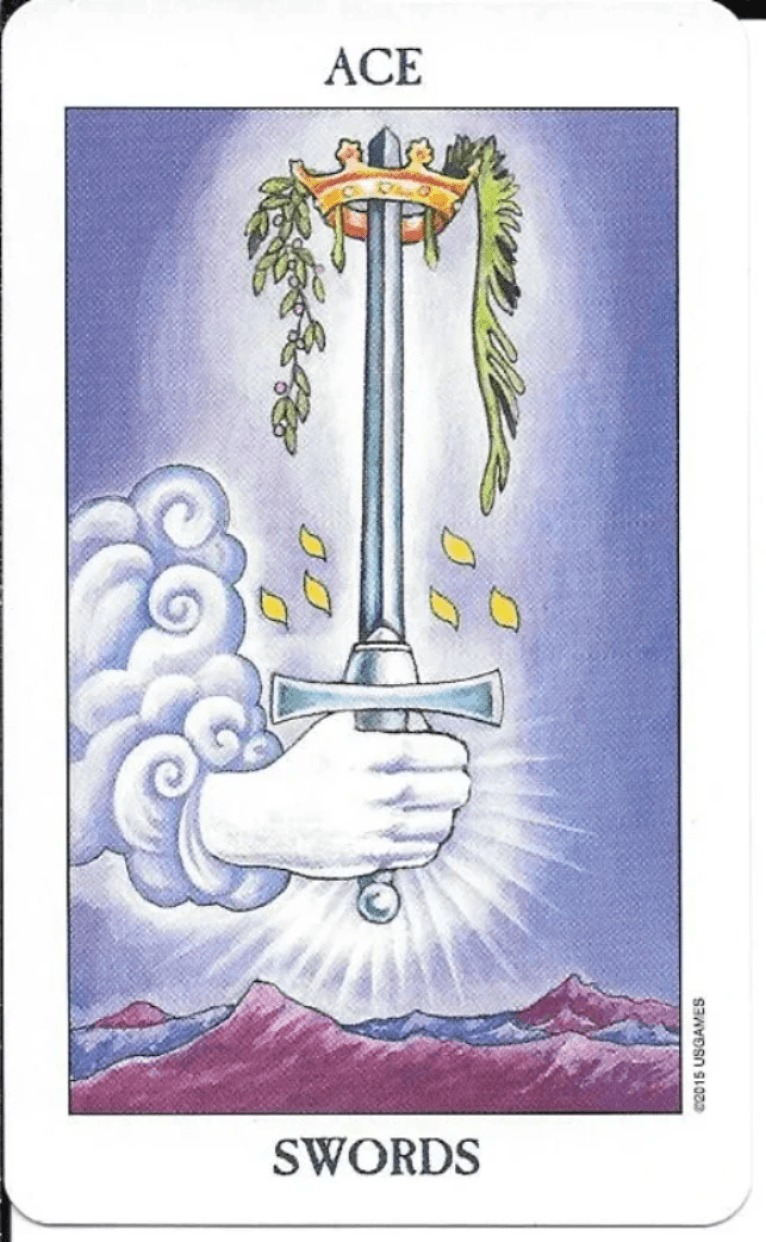
The Rider-Waite Ace of Swords:
portrays a gleaming silver-white hand emerging from a radiant silver cloud—an image that esoterically signifies the descent of the Supernal Will. This hand is not flesh and blood but a symbolic emanation of Kether, the first Sephirah on the Qabalistic Tree of Life. In Hermetic Qabalah, Kether is associated with pure, unmanifest Light—often attributed the color white—indicating the pristine origin of Divine Thought before it descends into form.
Held firmly in this spectral hand is a great upright sword, the archetypal symbol of the Ruach, or Reasoning Mind, representing discriminating consciousness and mental clarity. Upon the tip of this blade rests a golden crown—symbol of sovereign mental dominion—adorned with both a palm frond and an olive branch. These two botanical emblems are not mere decorations: they hold profound Hermetic significance.
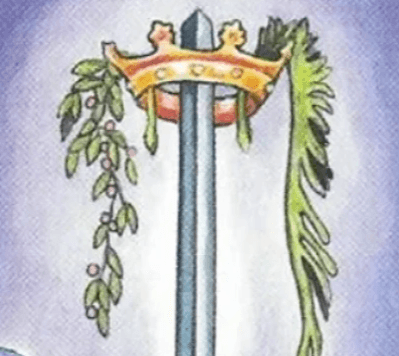
The palm, traditionally a symbol of victory through endurance and often associated with martyrdom or suffering, alludes to the trials that accompany the path of the rational mind when wielded without compassion or higher wisdom. It is the Will tested by fire. In contrast, the olive branch, long a signifier of peace and reconciliation, represents the higher path of clarity that brings mental harmony, healing, and enlightened resolution.
Thus, this Ace of Swords reveals the twofold potential of the Sword as the instrument of Will—it may sever illusion and bring illumination, or it may divide and destroy. It is the blade of discernment, but also of judgment. The sword, in Hermetic symbolism, is neither inherently good nor evil—it is the extension of the wielder’s I AM directive, and therefore, its effect depends upon the level of consciousness directing it.
In summary, the Ace of Swords is the primal archetype of the Logos in motion—the Word (Logos) that shapes reality through thought, intention, and speech. It is the dawning of truth and mental power, but it also comes with a warning: the clarity it brings can liberate or wound, depending on how well the wielder has aligned their Will with the Greater Light of the Divine.

The Crown atop the sword in the Rider-Waite Ace of Swords is a potent symbol of Kether, the first Sephirah on the Qabalistic Tree of Life. Known as The Crown, Kether represents the pure, undifferentiated source of Divine Will—the I AM before definition, the radiant singularity from which all existence emanates. It is the pre-formative spark of identity and intention before it descends into the differentiated Sephiroth below.

Surrounding or emerging from the Crown are six Yods, the sacred flame-shaped glyphs of the Hebrew letter Yod (י), which symbolize the initial impulse of Divine Fire—Spirit in seed form. These six Yods are not randomly placed; they echo the number six, directly alluding to Tiphareth, the 6th Sephirah, known as Beauty. Tiphareth is the harmonic center of the Tree, the Solar Heart, and is the seat of the Christed or Buddha consciousness—the perfected Human-Solar archetype who acts as a divine intermediary between the Supernal and the manifest worlds.
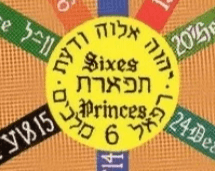
The Yods, therefore, imply that the Crown is not static, but contains within it the seed of the Solar Logos—the Higher Self or Over-Soul (Yechedah)—whose light shines fully in Tiphareth. This connection between Kether and Tiphareth is crucial in Hermetic Qabalah: it shows that the pure Will of the Divine finds its most beautiful and balanced expression in the enlightened heart of the human being.
Moreover, the association with Christ and Buddha in Tiphareth emphasizes not just illumination, but suffering and peace—the dual path of redemption and wisdom. Both masters endured trials and chose the path of compassion, speaking and acting as living embodiments of the Logos, the Divine Word made flesh. Thus, the six Yods are the fiery seeds of that same Logos, hinting that the sword of mental clarity and divine truth ultimately finds its rightful throne not in destruction, but in Beauty, Compassion, and Sacrifice—the central teachings of all Solar Avatars.

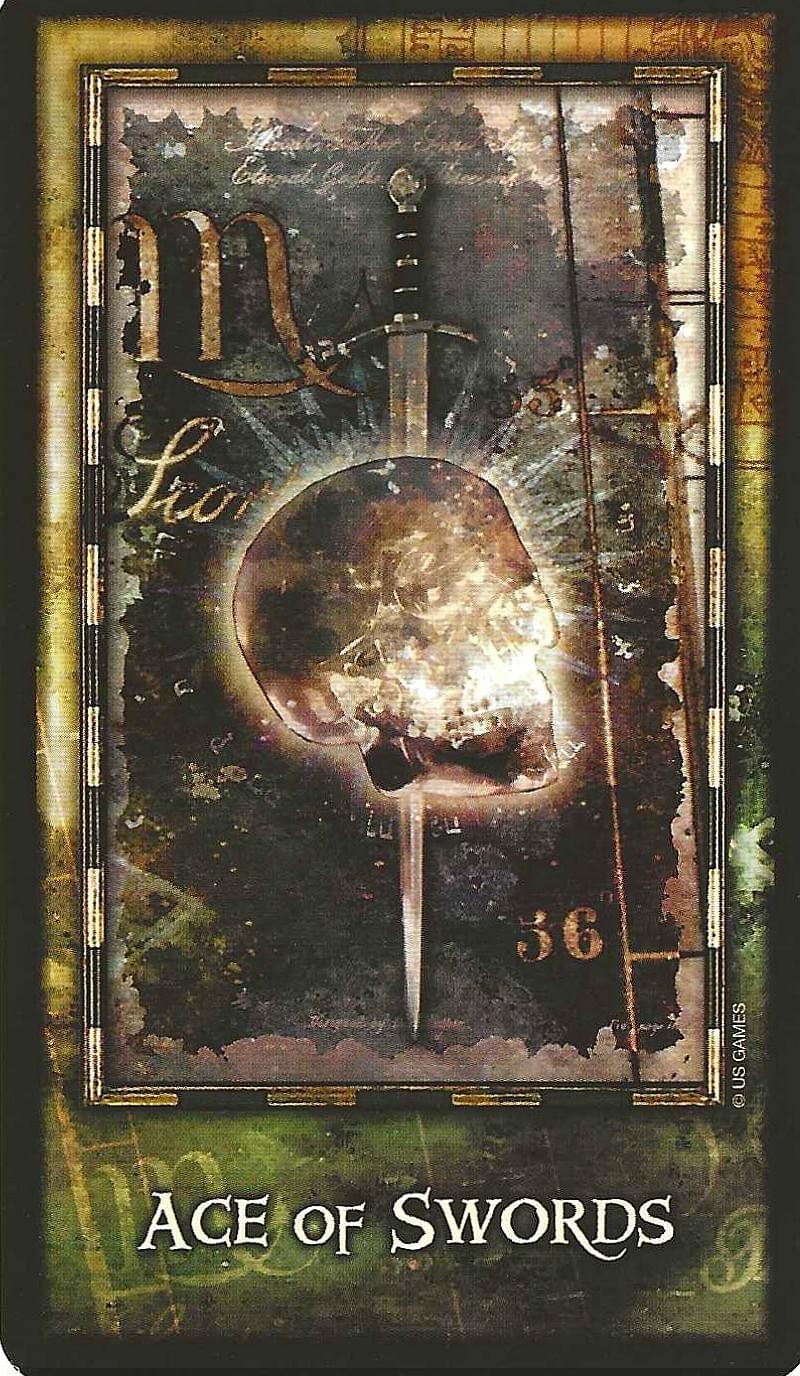
The Archeon Tarot-Ace of Swords
The Archeon Tarot – Ace of Swords presents a haunting and evocative image: a large crystal skull pierced by a downward-pointing double-edged sword. This striking symbol speaks volumes in Hermetic and Qabalistic language, as it both conceals and reveals the mysteries of the mind and the power of thought.
The crystal skull evokes ancient mysteries—Atlantean wisdom, ancestral memory, and the purified vessel of the mind. In esoteric traditions, the skull is not simply a memento mori; it is also the temple of consciousness, and when rendered in crystal, it suggests clarity, purity of thought, and the amplification of subtle psychic forces, such as clairvoyance, mental focus, and telepathic insight. It is the capstone of the manifest man, housing the spark of the Logos in the cerebral throne of Kether.
The double-edged sword, descending from above, is the archetype of the Ruach, the reasoning self or Solar Mind. Its downward position, however, implies an inversion of the usual upward-aspiring flame of Will. In the upright position, the Ace of Swords represents pure intellectual clarity, discipline, truth, and mental courage—forces that birth order out of chaos. But here, the sword's orientation carries a warning: should the mind fall from clarity into egoic delusion, the sword cuts both ways, leading to embarrassment, cruelty, illusion, and self-sabotage. This is the peril of unbalanced force or misaligned Will.
The number 56 and the astrological glyph—often overlooked in more mainstream decks—deserve special attention.
✧ The Number 56:
In standard Tarot numerology, the number 56 corresponds to the total number of Minor Arcana cards. This subtly implies that the Ace of Swords in the Archeon Tarot is not merely the beginning of a suit—it is the archetypal essence of the entire spectrum of human experience in action, since each Minor Arcana card arises from the impulse of its respective Ace. The Ace of Swords, therefore, is the seed-intelligence of all active motion, decision, and differentiation in the elemental world of Air—the world of thoughts, words, strategies, and ideologies.
From a Qabalistic angle, 56 reduces to 11 (5 + 6 = 11), the number of magickal mastery and the path of the Fool (0) into strength and equilibrium (2). Eleven also resonates with the invisible Sephirah Da’ath, the "false crown" or abyssal gate between the Supernal and lower worlds. This connects well with the skull motif—a kind of secret gnosis accessed through ordeal and inner clarity.
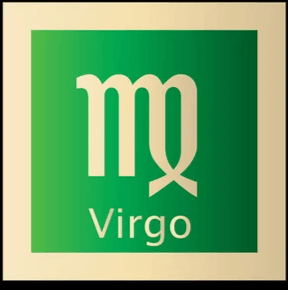
✧ The Astrological Symbol:
The glyph next to the number (depending on the edition—it is often Gemini, Libra, or Air) reinforces the intellectual realm. If Gemini, the mutable air sign, is shown, then the card emphasizes the duality of thought, the twin-edged nature of speech and intellect, and the paradoxes inherent in logic. If Libra is used, the sword becomes the blade of justice and equilibrium, weighing truth against illusion. If the glyph is the elemental symbol of Air (a triangle with a line through it), then the card functions as a pure elemental initiation—a ritual threshold into the mind's temple.
Conclusion:
The Archeon Ace of Swords is both a warning and a call to mastery. It speaks to the seeker who dares to peer into the mysteries of consciousness, to wield the blade of thought responsibly, and to recognize that the mind is a sacred tool—not a tyrant. Upright, this card reveals the will to clarity, insight, and vision. Inverted, it exposes the mind's shadow: confusion, cruelty, and the tyranny of the lower ego.

The fact that the appearance of Virgo on the Archeon Tarot Ace of Swords carries a very different yet equally potent esoteric charge from a normal Air sign. Virgo's presence on this Ace of Swords implies something more refined: an initiation into sacred order, discriminating intellect, and mental purification.
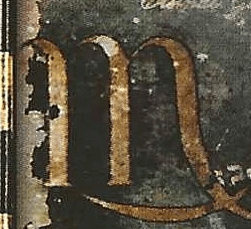
✧ Virgo on the Archeon Ace of Swords: The Sword of Sacred Discrimination
The Zodiacal sign of Virgo, ruled by Mercury, is the mutable Earth sign—the Priestess-Scribe of the zodiac. Virgo governs discernment, meticulous detail, healing, purification, and service. It is a sign that wields reason and structure like a scalpel: precise, humble, and aligned with higher order. When placed on the Ace of Swords, a traditionally Air-element card, this Earth-Mercury blend anchors intellect into practical wisdom. It is the power of the Word not merely to cut illusion, but to organize reality into sanctified order.
✧ Mercury’s Dual Function: Mind & Medicine
Mercury rules both Gemini and Virgo, but expresses very differently in each:
In Gemini, Mercury is fast, dualistic, abstract—the chatter of the Ruach.
In Virgo, Mercury becomes discriminating intelligence, the mind that heals, categorizes, edits, and purifies thought into embodied form.
This aligns the Archeon Ace of Swords with the mind of the Healer-Magus—one who not only knows the blade of intellect, but uses it with surgical precision, to remove disease, falsehood, and chaos in service to the whole.
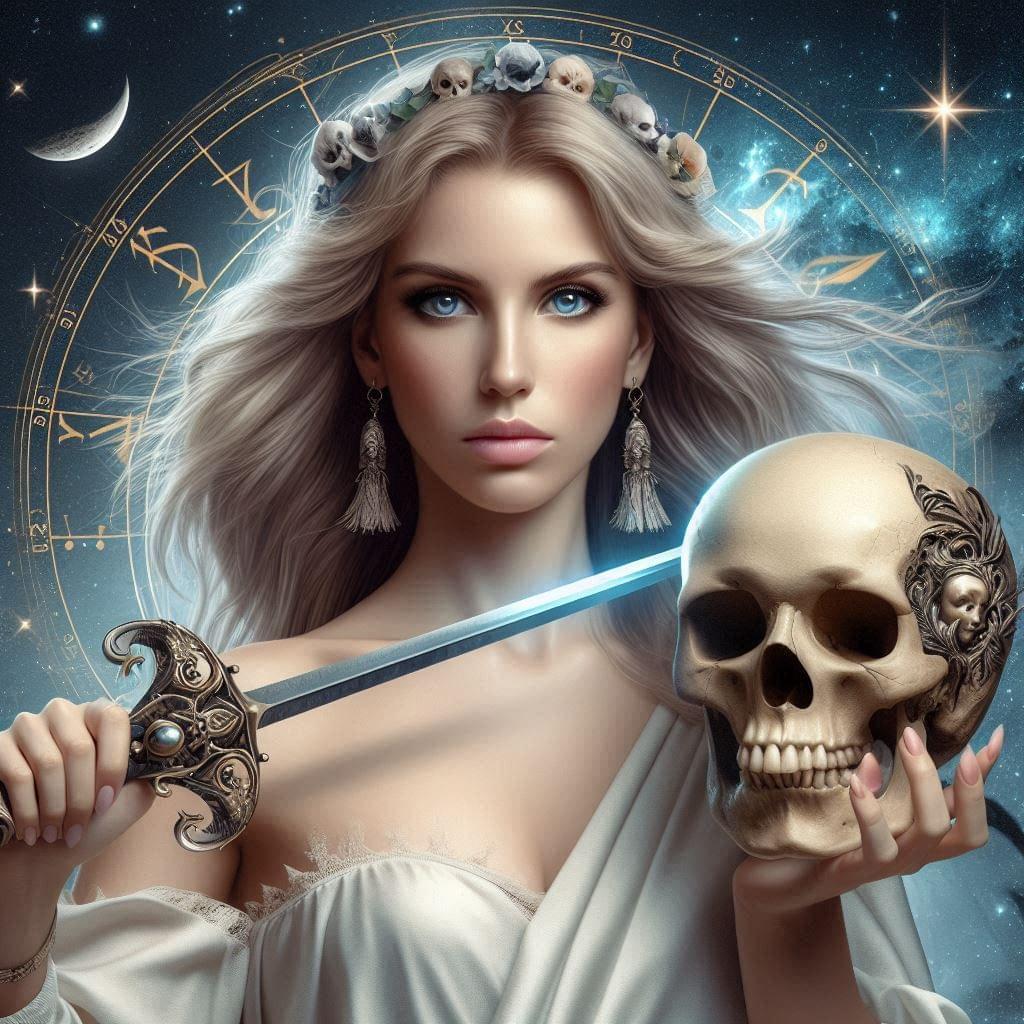
✧ Virgo, the Maiden, and the Crystal Skull
The crystal skull in the Archeon image—pierced by the downward-pointing sword—now takes on a Virgin Priestess resonance. In alchemical symbolism, Virgo is the Virgo Intacta, the untouched vessel, representing clarity of mind and mental chastity—not in the sexual sense, but in the refusal to be corrupted by illusion or falsehood.
The sword descending into the crystal skull may then signify:
A cleansing incision into mental stagnation.
The initiation of the mind into holy service.
The grounding of Logos into sacred embodiment.
Thus, Virgo elevates this Ace into the Sword of Analytical Perfection—a blade that does not destroy for power, but cuts away confusion, infection, or disorder with sacred responsibility.
✧ The Shadow of Virgo: Inverted Meanings
When inverted (as I noted earlier), this Virgoan energy can become:
Over-analysis and perfectionism leading to paralysis.
Cruel criticism instead of constructive discernment.
A descent into mental rigidity, self-judgment, or emotional disconnection.
Hence, the inverted Ace warns: the mind, when corrupted by fear or shame, becomes a tyrant rather than a tool of healing. One must keep the Sword aligned with the Higher Mercury—Hermes as psychopomp and guide—not as the babbling critic of the lesser ego.
✧ In Summary:
The appearance of Virgo on the Archeon Ace of Swords suggests that this is not just the Sword of the intellect—it is the Sword of Sacred Clarity, wielded by the healer-priest or hermetic scribe. It declares:
“Let the Word be purified through discernment.”
“Let the Sword be used in service, not domination.”

✧ The Ace of Swords & Dialectics: The Blade of Mind that Cuts and Unites
The Ace of Swords is the root of the element of Air in the Minor Arcana. It symbolizes the primal emergence of the intellect, the Logos, the first flash of awareness that can separate light from darkness, truth from illusion, idea from formlessness. In the philosophical world, this same function is known as Dialectic—the process of arriving at truth through structured contrast, opposition, and synthesis.
Dialectics, especially in the classical Platonic and Hegelian traditions, is the art of thought refined through:
Thesis (a statement or belief),
Antithesis (its opposing or challenging idea),
And Synthesis (a higher understanding that reconciles and transcends both).
This triune process perfectly mirrors the triple function of the Ace of Swords:
It asserts (thesis),
Cuts and challenges (antithesis),
And resolves into clarity (synthesis).
✧ The Sword as Dialectical Instrument
In Hermetic symbolism, the Sword is a weapon of discrimination—it divides and categorizes, but it also unites by slicing through illusion, revealing the True Form behind appearances.
In Dialectic:
The Sword questions dogma.
It destabilizes the ego’s fixed position.
It clarifies by removing falsehood.
And it ultimately brings peace, not through passivity, but through understanding won by rigorous inquiry.
This is the mind of the Magus or Philosopher-King—not content with surface truth, but descending like the Sword into the Skull to extract the pearl of Gnosis.
✧ Qabalistic Layer: Aleph, Zain, and the Logos
From a Qabalistic point of view:
The Ace of Swords corresponds with Zain (ז), the Hebrew letter meaning "sword" or "weapon," and aligned with the Path from Binah (Understanding) to Tiphareth (Beauty).
Zain implies that understanding is achieved by engaging with opposites—the feminine principle of Binah must be filtered through the sword of mental clarity before the harmony of Tiphareth can be born.
Furthermore, the Divine Word (Logos)—the root of dialectics—is the creative utterance that divides the Waters in Genesis: “Let there be Light.” The Ace of Swords is this Logos—the cutting Word that births Cosmos from Chaos.
✧ Virgo, Mercury, and the Dialectical Method
Reintegrating Virgo, the sign shown on the Archeon Tarot Ace of Swords, we can see the Virgoan affinity for:
Analysis,
Editing,
Order through refinement.
These are all Mercurial dialectical skills. Mercury in Virgo doesn’t chatter like Gemini—it perfects through process, tests claims, and purifies statements into crystalline truths. Thus, the Virgo glyph amplifies the Ace’s dialectical function: the Mind is not a sword of war, but of clarity, healing, and intellectual alchemy.
✧ In Summary:
The Ace of Swords is the Tarot’s emblem of Dialectic Intelligence—the Logos Blade of Truth:
It questions boldly (thesis),
It cuts illusions apart (antithesis),
And it reveals the higher truth (synthesis).
It is both the mental weapon and the Hermetic tool of alchemical speech, sacred dialogue, and evolution of consciousness.

✧ The Ace of Swords: The Blade of Ideological Genesis and Revelation
The Ace of Swords, as the root of the Element of Air in the Tarot, is the primordial spark of thought—a raw, unfiltered influx of mind-force that can either liberate or devastate. This card does not whisper; it cleaves. It is the sacred blade of the Logos, the Sword of Divine Will piercing into the realm of form. Where it strikes, nothing remains the same.
At its most immediate level, the Ace of Swords often signals a power struggle—a battle of wits, ideologies, or intellectual wills. These conflicts can manifest on every scale:
between lovers,
co-workers,
families,
or even between nations.
This is the card of the debate that turns cutting, the argument that unravels illusion, the truth that wounds before it heals. As such, the Ace of Swords warns: though one voice may triumph, victory does not always favor the wise—only the most forceful. Here we are reminded that truth and dominance are not synonymous, and that the most aggressive position may not be the most evolved.

✧ The Sword as the "Death Suit"
In traditional Tarot, the Suit of Swords is often feared—known as the "Death Suit"—because it deals not with external threats, but with the often violent operations of the mind:
intellectual cruelty,
emotional coldness,
rigid belief systems,
psychological trauma.
The Ace, then, is the seed of all these mental extremes, but also their resolution. It is the Mind as Creator and Destroyer—the flame-tongue that both reveals and consumes. Like a ritual blade or the flaming sword that guards Eden, the Ace of Swords guards the gate of truth with terrible beauty.
Yet in every act of conflict, even the most painful, lies the seed of evolution. As ideas are tested and ideologies clash, new truths are born, old ones are slain. This is the secret gift of the Ace of Swords—it compels clarity, even though suffering. Preconceived notions are overturned, stagnant positions dismantled, and the sharp light of revelation sears through dogma like a sunbeam through mist.
✧ The Solar Logos and the Alchemy of Thought
Qabalistically, the Sword is a child of the union of:
the Mother—Unconscious, receptive, the Will-to-Form,
and the Father—Creative Spirit, the Will-to-Force.
Together, they give birth to thought—the first matter of Creation in the elemental plane of Air. In the Ace of Swords, this First Thought is depicted as pure, untouched by emotion, morality, or consequence. It simply is—a blade forged in the aether, waiting for the hand of the adept.
The six Yods falling from the Crown in many traditional depictions (and echoed energetically in the Archeon Tarot) link this Ace to Tiphareth, the sixth Sephirah on the Tree of Life—Beauty, the radiant Solar Self. Tiphareth is the sphere of revelation, sacrifice, and illumination. It represents the higher mind—the soul's voice behind the intellect. Thus, the Ace of Swords is not just conflict for its own sake, but the burning away of mental illusion so that Beauty may emerge.
✧ Revelation Through Struggle
This card often arrives at the threshold of revolution—whether inner or outer. It may herald a painful truth, a necessary conflict, or a cutting insight. Yet what emerges is not ruin, but revelation. The battle of minds becomes the forging ground of genius. The clashing of perspectives becomes the cauldron of new paradigms. The sword that severs also liberates.
Thus, the Ace of Swords is not just a card of thought—
it is a lightning-strike of Truth,
a mental exorcism,
a Solar Revelation of the Logos itself.
Would you like to include a personal ritual or pathworking where one takes up the Ace of Swords in the Astral and severs illusion from the subconscious? Or perhaps a sigil invoking the Solar Logos for use in ideation and mental clarity? Then click on the Chat button and ask for an individual ritual, honed to you.
WHEN THE ACE OF SWORDS is THROWN DURING A DIVINATION,
It implies.
- Mental clarity and inventiveness.
- Problems being overcome with original thinking.
- The dawning of a new intellectual process.
- Acting with logic and discrimination
- Strength in adversity. Out of evil some good will come. Something that looks bleak can surprisingly turn out to be promising.
- The beginning of an idea or information. The rise of Inner insight.
- Will power.
If reversed, it implies:
- This card depends on the surrounding cards to show whether it is fate or rebirth.
- Doom, this is the card of Morgan the Fate.
- Finality, Tragedy, and fate; However, it is release, freedom from past restraint and a new lightness and/or a kind of salvation.
- Vacillation.
Thank you for your interest, comments, and supportive donation. May you live long and prosper.
3 Western Hermetic Tarot and Magick websites helping people become more magic and less tragic since 2010
Traditional Tarot blogs.
Home page, Tarot Store, Master Tarot Classes, and nontraditional Tarot card comparisons.
Western Hermetic Magick Ritual and invocation website and blog.

